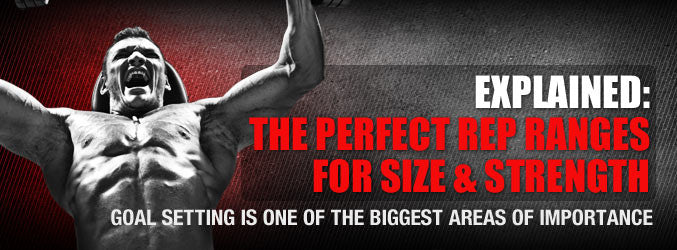
Goal setting is one of the biggest areas of importance for lifters. Most of the time, the goals set are fairly vague. You may hear “I want to grow bigger and stronger” or “I want to add twenty pounds of mass”. And early on in the process, unclear goals like this may get the job done. However, as the lifter moves from beginner status to intermediate status, gains arrive at a much slower pace. At that point, it is the duty of the intelligent lifter to modify his/her actions in the gym and kitchen based upon newly defined goals which are much more specific. “Getting big and strong” works when you’re 16 and new to lifting. When you’re 25, and you want to customize your training protocol to ensure bench press gains of 10% strength per year along with a lean body mass gain of 6 pounds per year, then you’re better know what repetition ranges you will be using in the gym, in order to meet these goals. Now, after much waiting, it is time to define size & strength, and discuss the lifting protocols which work best for each of them.
Let’s talk about strength
The goal of strength training is, well, to get stronger. Specifically, the fast-twitch muscle fibers of your body will grow faster and respond faster to demands placed upon them. As a result, you will be able to lift a heavier amount of weight. Using the stress system known as progressive overload, you will be increasing EITHER the amount of weight you use with each workout, or using the same weight for a greater number of repetitions during each workout. Your ability to contract your muscles will increase, and voila, you’ll grow stronger. This process, known as myofibrillar hypertrophy, will lead to an overall increase in the actin and myosin proteins in your muscle fibers.
Let’s talk about size
There is a fluid in your muscles known as cytoplasm which surrounds the myofibrils (muscle fibers). This fluid contains near-magical ingredients such as creatine phosphate, water, ATP, and glycogen. When the process of sarcoplasmic hypertrophy occurs, the amount of the fluid cytoplasm in the muscle increases. The result is, of course, new muscle SIZE. Slower, more controlled repetitions can lead to a greater collection of fluid in the muscle fiber area.

Training for Size Vs. Training for Strength
Now that you know the differences in strength and size at the muscle fiber level, you can learn to adjust your training to accommodate your specific goals.Your training will focus upon either strength (neuromuscular training) or size (metabolic training).
Strength:
Training for strength requires a system of lifting under extremely high stress, using 85 to 100% of your one-repetition maximum lifting weight. Train using heavy, explosive lifting manner for 1 to 40 seconds, then take a rest of 1.5 to 4 minutes before starting the next set. These are SHORT sets, but they are extremely heavy and intense.
Size:
Training for size requires the use of less weight and less intensity, for a greater period of time. Train using a weight that is 60 to 75% of your one-repetition maximum. This set should last 40 to 70 seconds, and your rest period should only last about 1 minute before the next set is started. The strength gap of 75 to 85% of your one-repetition maximum does not provide adequate return on investment to use on a regular basis, which is why many lifters who live in this semi-comfort zone see less than optimal gains.
Measuring One-Repetition Strength
It’s not that difficult to record your one-repetition for any lift in the gym. Make a rough estimate, and try to lift it. If you can, that is your new 1RM, or one-repetition maximum. Rest 5 minutes and try it with 5 or 10 more pounds on the bat. It won’t take long to nail down exactly how strong you are. Remember to write it down!
Their application should be common sense. Training with 1 to 5 repetitions per set will be mostly myofibrillar for strength.
Training with 15 or more repetitions per set is largely endurance training, with very little strength and just a bit of sarcoplasmic training for size.
Always use a spotter when training for your one-repetition maximum weight. A difference of just 5 pounds can be the difference in a safe & successful lift, and a severe gym injury that’ll keep you off the weights for two months. Also, the presence of a spotter means you can focus solely on lifting, and not about safety, which means you may actually move more weight as a result!

Getting to work in the gym
Now that you know how much weight to use, for how many repetitions, and how much rest to use following a set, you’re ready to get to work in the gym! Remember that training in this manner will require a journal so that you can not only record your lifts for maximum percentages, but also so that you can top these percentages when you train the following week. Write out each set, then take this journal home and do some math! Learn your 1RM as well as the percentages associated with it. Predict your lifts for the following week, then show up and complete those lifts! After a few weeks, you should be able to predict how you’ll perform in each lift the following week. And of course, remember to adjust your caloric consumption, supplement use, and overall rest & recovery so that your body can grow to meet these new demands you are placing upon it.
In closing…
If you lift heavier weights each time you visit the gym, you’re going to grow stronger. If you grow stronger and eat plenty of good food and take your supplements, then you’re going to grow your muscle bigger. These are basics which will always work. Adjusting your repetition schemes is a terrific way to ensure you make the greatest gains in the shortest period of time. Good luck!


